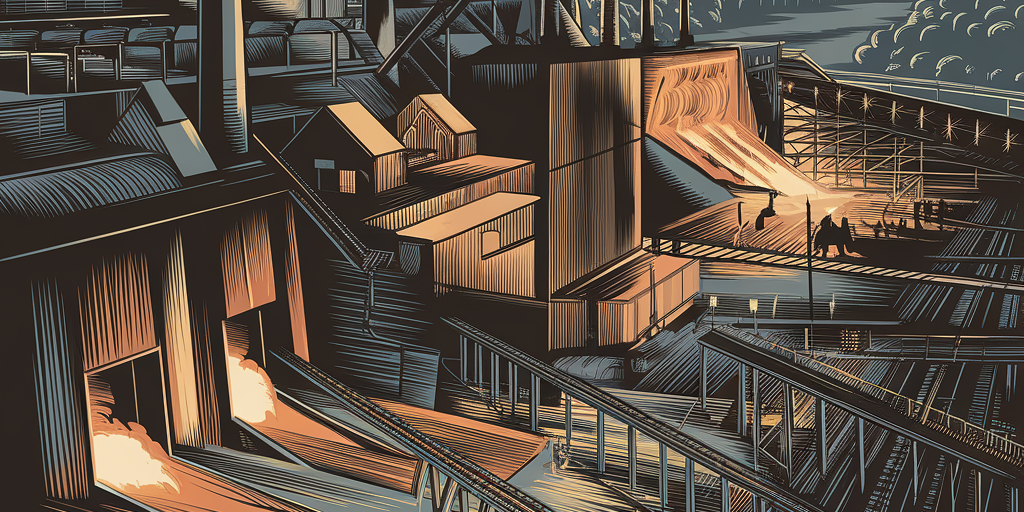Introduction: Innovation and Obsolescence in the Steel City
Pittsburgh’s steel dominance wasn’t just built on raw resources — it was driven by relentless technological innovation. From the Bessemer process that launched an empire to the outdated open-hearth furnaces that spelled its collapse, Pittsburgh’s rise and fall as America’s steel capital is a story of industrial evolution and failure to adapt.
This in-depth look explores the technologies, processes, and decisions that shaped Pittsburgh’s steel industry, offering a new perspective beyond personalities like Carnegie and Frick. It’s the story of machines, furnaces, and missed opportunities — the backbone of the Steel City.
The Technological Foundations: Why Pittsburgh Was Perfect for Steel
Pittsburgh’s natural geography set the stage — but technology turned potential into power:
- High-quality bituminous coal (coking coal) from Western Pennsylvania fueled the blast furnaces.
- Rivers and railroads allowed easy shipping of iron ore, limestone, and finished steel.
- The proximity to railroads, glassmakers, and foundries created a self-feeding industrial ecosystem.
The city’s early iron works used charcoal blast furnaces, but it was the Bessemer process that changed everything.
The Bessemer Process: Pittsburgh’s Industrial Superweapon
What It Did:
- Converted molten pig iron into steel by blowing air through it to remove impurities.
- Cut production time from days to minutes.
- Dropped costs by up to 80%, making steel affordable for railroads, bridges, and buildings.
Andrew Carnegie’s 1875 J. Edgar Thomson Works was one of the first to fully embrace this method, igniting Pittsburgh’s boom.
Impact:
- By 1900, Pittsburgh produced more steel than Britain.
- Powered the nation’s rapid industrial expansion.
Open-Hearth Furnaces: The Next Step, and a Fatal Flaw
By the early 20th century, Pittsburgh mills transitioned to open-hearth furnaces, which allowed:
- Greater control over the steel’s chemical composition.
- Production of larger batches to meet skyscraper and ship demands.
But:
- Open-hearths were incredibly labor and energy intensive.
- As new technologies emerged (like the basic oxygen furnace), Pittsburgh’s steel barons resisted costly upgrades.
This short-term profit focus locked the industry into obsolete systems.
Labor, Automation, and the Cost of Falling Behind
Pittsburgh’s mills were massive, but their reliance on manpower remained high:
- Thousands worked grueling shifts feeding open-hearth furnaces.
- Meanwhile, Japan and Europe invested heavily in continuous casting and automation.
Result:
- By the 1960s, Pittsburgh mills were 10-20 years behind foreign competitors.
- Costs soared, quality fell, and market share collapsed.
Environmental Toll: Smoke, Slag, and Rivers of Waste
Pittsburgh’s outdated methods had environmental consequences:
- Air pollution so thick it blocked out the sun.
- Rivers choked with industrial waste, killing ecosystems.
- The city became infamous for pollution — a symbol of the environmental cost of unchecked industry.
These issues fed into the national shift against heavy industry, further isolating Pittsburgh’s mills.
What Could Have Saved the Industry? Missed Innovations
Key Technologies Pittsburgh Ignored or Delayed:
- Basic Oxygen Furnace (BOF): 5x faster than open-hearth; ignored until too late.
- Continuous Casting: Produces steel directly into shape; reduces waste.
- Mini Mills: Smaller, electric arc plants using recycled scrap — the future Pittsburgh missed.
Other U.S. regions and foreign competitors adopted these advancements in the 1950s-1970s — Pittsburgh didn’t.
The Final Blow: The 1980s Collapse and Legacy
By the 1980s, foreign steel flooded the U.S. market. Pittsburgh’s bloated, outdated mills couldn’t compete:
- Bethlehem Steel, Jones & Laughlin, and Homestead Works collapsed.
- 150,000 jobs vanished in under a decade.
Legacy:
- Pittsburgh pivoted to tech, finance, and healthcare.
- Carrie Blast Furnaces and preserved sites serve as reminders of the industrial might — and technological stagnation — that built the city.
Conclusion: The Rise, Innovation, and Technological Failure of Pittsburgh Steel
Pittsburgh’s steel empire was forged by brilliant technology — and ultimately destroyed by failure to innovate. Its story is a case study in industrial rise and collapse, where short-term profits outweighed long-term vision.
Yet, the machines, mills, and furnaces that once roared with molten metal still stand in parts of the city — silent sentinels of an age when Pittsburgh built the world.









